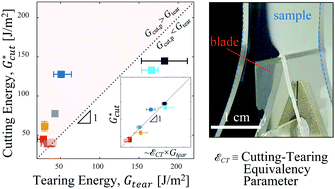On the relationship between cutting and tearing in soft elastic solids†
Abstract
Unique observations of cutting energy in silicone elastomers motivate a picture of soft fracture that qualitatively and quantitatively links far-field tearing with push cutting for the first time. For blades of decreasing tip radii, the cutting energy decreases until it reaches a plateau that suggests a threshold for failure. A super-molecular damage zone, necessary for new surface creation, is defined using the tip radius at the onset of this threshold. Modifying the classic Lake–Thomas theory, in which failure occurs within a molecular plane, to this super-molecular zone provides order-of-magnitude agreement with the cutting energy threshold. Together, the threshold fracture energy and damage length scale define criteria for failure that, when implemented in finite element simulation, quantitatively reproduce the increase in cutting energy with increasing blade radius outside of the plateau. The rate of increase depends on the constitutive response of the material, with more neo-Hookean solids requiring a larger failure force per incremental increase in blade radius as observed experimentally. This combination of a geometry-independent failure threshold (from the cutting energy plateau) and a need to account for the role of material deformability in the stress concentration found at the crack tip (from the rate of cutting energy increase with blade radius) align with the discovery of a new dimensionless group. This new parameter proportionally maps cutting energy to the energy required to tear a sample under far-field loading conditions by using ultimate properties obtained in uniaxial tension.

- This article is part of the themed collections: Soft Matter Editor-in-Chief's Choice, Soft Matter Most Popular 2021 and 2021 Soft Matter Emerging Investigators


 Please wait while we load your content...
Please wait while we load your content...